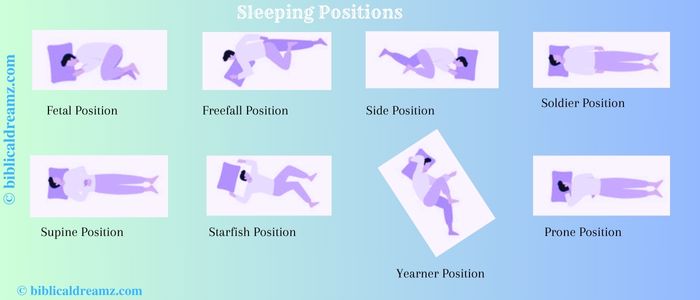Does your sleeping position affect your dreams?

When we fall into the realm of sleep, our minds embark on a mysterious journey, weaving together a spectrum of dreams. But have you ever wondered if there is a connection between the way you sleep and the dreams you experience? In this article, we will explore the potential influence of different sleeping positions on the content and intensity of our dreams.
Related: What is the biblical explanation of sleep paralysis?
What is the link between sleeping positions and dreams?
Studies have suggested that the position in which we sleep may have an impact on the nature of our dreams. Although research in this field is still evolving, anecdotal evidence and some scientific findings indicate a potential connection. Let’s take a closer look at the various sleeping positions and their possible effects on dreams.
The Supine Position:
Sleeping on your back, also known as the supine position, is considered one of the most common sleeping postures. Interestingly, this position has been associated with an increased likelihood of vivid, intense dreams. The reason behind this phenomenon might be the alignment of the body, allowing for better blood flow to the brain and facilitating brain activity during sleep.
The Prone Position:
Contrasting with the supine position, sleeping on your stomach, known as the prone position, might yield different dream experiences. While there is limited scientific evidence specifically linking this position to dreams, anecdotal accounts suggest that prone sleepers may have dreams that involve more intense feelings of pressure. Further research is needed to establish a definitive connection.
Related: Meaning of biting your tongue in your sleep
The Side Position:
Sleeping on your side, be it the left or right side, is a prevalent sleeping position among individuals. Side sleepers often report a variety of dream experiences, ranging from pleasant and imaginative to more intense and vivid dreams. This position is believed to facilitate better circulation and reduce the occurrence of sleep disturbances, potentially leading to enhanced dream content.
Get instant dream insights with our Free Dream Interpretation App
The Fetal Position:
Many people find comfort in sleeping curled up in the fetal position, resembling the posture we once assumed in the womb. This position is associated with a sense of security and relaxation. In terms of dream experiences, sleeping in the fetal position may evoke dreams that reflect emotions such as vulnerability, protection, or introspection.
The Freefall Position:
For those who prefer to sleep on their stomach with their arms tucked under the pillow, the freefall position, dream experiences can take on a unique flavor. While scientific evidence is limited, anecdotal reports suggest that individuals who sleep in this position often have dreams characterized by a sense of adventure or even a feeling of falling. The openness of this posture may contribute to a heightened sense of freedom and excitement within the dream realm.
The Starfish Position:
Sleeping on your back with your arms and legs spread out, known as the starfish position, can also have an impact on the dream landscape. Although research specifically examining this position’s effect on dreams is scarce, individuals who favor the starfish position have described dreams that involve a sense of vastness and reaching for something beyond their grasp. This position may evoke a feeling of openness and unlimited possibilities within the dream world.
The Log Position:
Sleeping on your side with your arms and legs extended straight, resembling a log, can influence the nature of your dreams. Individuals who sleep in the log position often report dreams that involve social interactions or events that reflect their waking life experiences. The alignment of the body in this position may contribute to a sense of stability and connection within the dream narrative.
The Soldier Position:
The soldier position involves sleeping on your back with your arms resting by your sides, similar to a soldier at attention. Although there is limited scientific research examining this position’s effect on dreams, anecdotal evidence suggests that individuals who sleep in the soldier position often have dreams characterized by discipline and a sense of duty. This upright posture may create a sense of alertness and control within the dream realm.
The Yearner Position:
For those who sleep on their side with their arms stretched out in front, the yearner position, dreams may take on a distinctive tone. Individuals who favor the yearner position have reported dreams that revolve around decision-making, pursuing goals, or embarking on new ventures. The openness of the body in this position may reflect a sense of readiness and determination within the dream realm.
The Hugging Position:
Sleeping on your side with your arms wrapped around a pillow or cuddling a partner, known as the hugging position, can influence the dreamscape in unique ways. Anecdotal accounts suggest that individuals who sleep in the hugging position often have dreams imbued with emotional connections. The physical act of holding something close may evoke a sense of comfort and intimacy within the dream narrative.
The Upside-Down Position:
For the adventurous souls who dare to challenge convention, sleeping in an upside-down position, such as hanging off the bed or using inversion equipment, dreams may take an unconventional turn. Individuals who experiment with sleeping upside down have reported dreams filled with curiosity. The unusual bodily orientation may introduce a sense of novelty and imaginative exploration within the dream realm.
The Multiple Positions:
It is worth noting that most individuals do not maintain a single sleeping position throughout the night. We often change positions unconsciously. This combination of multiple sleeping positions can introduce a variety of dream experiences, as each position potentially influences different stages of sleep and dream cycles.
Such diversity in sleeping postures may contribute to a rich tapestry of dreams, incorporating elements from various positions and enhancing the complexity of dream narratives.
Conclusion
While the connection between sleeping positions and dreams is an area that requires further exploration, it is evident that our sleep posture might influence the content and intensity of our dreams. It’s important to note that individual variations in dream experiences exist, and other factors such as sleep quality and mental well-being can also shape our dreams.
Understanding the intricacies of the human mind and the science of sleep continues to be a fascinating endeavor. As researchers delve deeper into the realm of sleep and dreams, we inch closer to unraveling the secrets that lie within our slumbering hours. Until then, let us embrace the wonder of our dreams, regardless of the position we find ourselves in when we drift off to sleep.
So, the next time you slip beneath the covers and surrender to sleep, consider the position you assume and wonder what dreams await you in the depths of slumber. The symphony of your sleeping body and wandering mind may unlock hidden realms, where anything is possible and the boundaries of reality blur.





